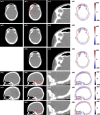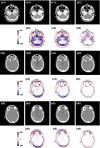Learning-based CBCT correction using alternating random forest based on auto-context model
- PMID: 30471129
- PMCID: PMC7792987
- DOI: 10.1002/mp.13295
Learning-based CBCT correction using alternating random forest based on auto-context model
Abstract
Purpose: Quantitative Cone Beam CT (CBCT) imaging is increasing in demand for precise image-guided radiotherapy because it provides a foundation for advanced image-guided techniques, including accurate treatment setup, online tumor delineation, and patient dose calculation. However, CBCT is currently limited only to patient setup in the clinic because of the severe issues in its image quality. In this study, we develop a learning-based approach to improve CBCT's image quality for extended clinical applications.
Materials and methods: An auto-context model is integrated into a machine learning framework to iteratively generate corrected CBCT (CCBCT) with high-image quality. The first step is data preprocessing for the built training dataset, in which uninformative image regions are removed, noise is reduced, and CT and CBCT images are aligned. After a CBCT image is divided into a set of patches, the most informative and salient anatomical features are extracted to train random forests. Within each patch, alternating RF is applied to create a CCBCT patch as the output. Moreover, an iterative refinement strategy is exercised to enhance the image quality of CCBCT. Then, all the CCBCT patches are integrated to reconstruct final CCBCT images.
Results: The learning-based CBCT correction algorithm was evaluated using the leave-one-out cross-validation method applied on a cohort of 12 patients' brain data and 14 patients' pelvis data. The mean absolute error (MAE), peak signal-to-noise ratio (PSNR), normalized cross-correlation (NCC) indexes, and spatial nonuniformity (SNU) in the selected regions of interest (ROIs) were used to quantify the proposed algorithm's correction accuracy and generat the following results: mean MAE = 12.81 ± 2.04 and 19.94 ± 5.44 HU, mean PSNR = 40.22 ± 3.70 and 31.31 ± 2.85 dB, mean NCC = 0.98 ± 0.02 and 0.95 ± 0.01, and SNU = 2.07 ± 3.36% and 2.07 ± 3.36% for brain and pelvis data.
Conclusion: Preliminary results demonstrated that the novel learning-based correction method can significantly improve CBCT image quality. Hence, the proposed algorithm is of great potential in improving CBCT's image quality to support its clinical utility in CBCT-guided adaptive radiotherapy.
Keywords: CBCT correction; adaptive radiotherapy; alternating random forest; feature selection.
© 2018 American Association of Physicists in Medicine.
Conflict of interest statement
The authors have no conflicts to disclose.
Figures















Similar articles
-
Paired cycle-GAN-based image correction for quantitative cone-beam computed tomography.Med Phys. 2019 Sep;46(9):3998-4009. doi: 10.1002/mp.13656. Epub 2019 Jul 17. Med Phys. 2019. PMID: 31206709 Free PMC article.
-
Dosimetric study on learning-based cone-beam CT correction in adaptive radiation therapy.Med Dosim. 2019 Winter;44(4):e71-e79. doi: 10.1016/j.meddos.2019.03.001. Epub 2019 Apr 1. Med Dosim. 2019. PMID: 30948341 Free PMC article.
-
Improving Image Quality of Cone-Beam CT Using Alternating Regression Forest.Proc SPIE Int Soc Opt Eng. 2018 Feb;10573:1057345. doi: 10.1117/12.2292886. Epub 2018 Mar 9. Proc SPIE Int Soc Opt Eng. 2018. PMID: 31456600 Free PMC article.
-
An unsupervised dual contrastive learning framework for scatter correction in cone-beam CT image.Comput Biol Med. 2023 Oct;165:107377. doi: 10.1016/j.compbiomed.2023.107377. Epub 2023 Aug 15. Comput Biol Med. 2023. PMID: 37651766
-
Shading correction for on-board cone-beam CT in radiation therapy using planning MDCT images.Med Phys. 2010 Oct;37(10):5395-406. doi: 10.1118/1.3483260. Med Phys. 2010. PMID: 21089775
Cited by
-
Male pelvic multi-organ segmentation aided by CBCT-based synthetic MRI.Phys Med Biol. 2020 Feb 4;65(3):035013. doi: 10.1088/1361-6560/ab63bb. Phys Med Biol. 2020. PMID: 31851956 Free PMC article.
-
Synthetic CT generation based on CBCT using improved vision transformer CycleGAN.Sci Rep. 2024 May 20;14(1):11455. doi: 10.1038/s41598-024-61492-7. Sci Rep. 2024. PMID: 38769329 Free PMC article.
-
Using a patient-specific diffusion model to generate CBCT-based synthetic CTs for CBCT-guided adaptive radiotherapy.Med Phys. 2025 Jan;52(1):471-480. doi: 10.1002/mp.17463. Epub 2024 Oct 14. Med Phys. 2025. PMID: 39401286
-
Machine-learning based classification of glioblastoma using delta-radiomic features derived from dynamic susceptibility contrast enhanced magnetic resonance images: Introduction.Quant Imaging Med Surg. 2019 Jul;9(7):1201-1213. doi: 10.21037/qims.2019.07.01. Quant Imaging Med Surg. 2019. PMID: 31448207 Free PMC article.
-
CBCT-based synthetic CT generation using generative adversarial networks with disentangled representation.Quant Imaging Med Surg. 2021 Dec;11(12):4820-4834. doi: 10.21037/qims-20-1056. Quant Imaging Med Surg. 2021. PMID: 34888192 Free PMC article.
References
-
- Xing L, Thorndyke B, Schreibmann E, et al. Overview of image‐guided radiation therapy. Med Dosim. 2006;31:91–112. - PubMed
-
- Niu TY, Zhu L. Overview of x‐ray scatter in cone‐beam computed tomography and its correction methods. Curr Med Imaging Rev. 2010;6:82–89.
-
- Siewerdsen JH, Daly MJ, Bakhtiar B, et al. A simple, direct method for x‐ray scatter estimation and correction in digital radiography and cone‐beam CT. Med Phys. 2006;33:187–197. - PubMed
MeSH terms
Grants and funding
LinkOut - more resources
Full Text Sources
Miscellaneous

